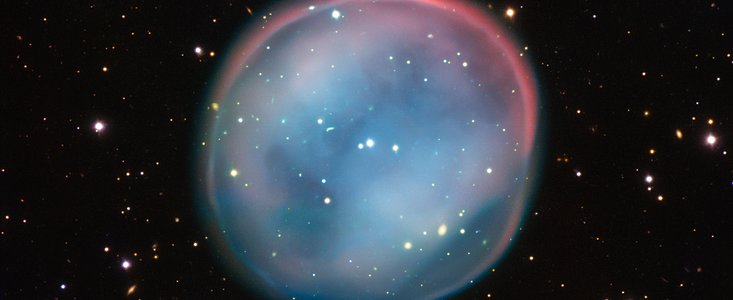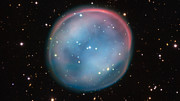Comunicato Stampa
Il fantasma di una stella morente
05 Agosto 2015
Questa sfera straordinaria, illuminata come il fantasma di una stella nel buio inquietante dello spazio, appare quasi soprannaturale e misteriosa, ma è un oggetto astronomico familiare: una nebulosa planetaria, ciò che resta di una stella morente. Questa è la migliore immagine mai ottenuta dell'oggetto, in realtà poco noto, chiamato ESO 378-1: è stata catturata dal VLT (Very Large Telescope) dell'ESO nel nord del Cile.
Soprannominata la Nebulosa Civetta Meridionale, questa sfera luccicante è una nebulosa planetaria con un diametro di quasi quattro anni luce. Il suo nome popolare la lega alla cugina dell'emisfero settentrionale, la Nebulosa Civetta. ESO 378-1 [1], catalogata anche come PN K 1-22 e PN G283.6+25.3, si trova nella costellazione dell'Idra.
Come tutte le nebulose planetarie, ESO 378-1 è un fenomeno relativamente breve, dato che dura solo qualche decina di migliaia di anni, mentre la vita media di una stella è di svariati miliardi di anni [2].
Le nebulose planetarie vengono formate dal gas in espansione, ejettato dalla stella morente. Anche se sono oggetti brillanti e molto interessanti nelle fasi iniziali della formazione, queste bolle svaniscono velocemente quando il gas che le forma si allontana e la stella centrale diviene più fioca.
Perchè si formi una nebulosa planetaria, la stella deve avere una massa inferiore a circa otto volte la massa del Sole. Le stelle più pesanti di questo limite finiranno la loro vita in modo più teatrale, con un'esplosione di supernova.
Le stelle più piccole, mentre invecchiano iniziano a perdere gli strati esterni del gas a causa dei venti stellari. Dopo che la maggior parte di questi strati si sono dispersi, il nucleo centrale caldo inizia a emettere radiazione ultravioletta che ionizza il gas circostante. La ionizzazione fa risplendere di colori vivaci il gas di queste spettrali bolle di gas in espansione.
Dopo che la nebulosa planetaria è svanita, il resto stellare brucerà ancora per un miliardo di anni prima di consumare tutto il carburante rimasto. Diventerà una nana bianca, piccola ma calda e densissima, che si raffredderà lentamente nel corso di miliardi di anni. Il Sole produrrà una nebulosa planetaria tra parecchi miliardi di anni e passerà gli anni della sua vecchiaia come nana bianca.
Le nebulose planetarie svolgono un ruolo cruciale nell'arricchimento chimico e nell'evoluzione dell'Universo. Gli elementi come carbonio e azoto, così come alcuni elementi più pesanti, vengono creati da queste stelle e restituiti al mezzo interstellare. Da questo materiale si formano poi nuove stelle, pianeti e, infine, anche la vita. Questo è li motivo della famosa frase di Carl Sagan: "Siamo fatti della stessa materia delle stelle".
Questa fotografia è parte del programma Gemme Cosmiche dell'ESO, un'iniziativa di divulgazione per produrre immagini di oggetti interessanti o anche semplicemente belli sfruttando i telescopi dell'ESO a scopi di comunicazione e didattica. Il programma usa i telescopi quando questi non possono essere usati per osservazioni scientifiche. Poichè però i dati potrebbero comunque risultare utili anche per scopi scientifici, vengono messi a disposizione degli astronomi attraverso l'archivio scientifico dell'ESO.
Note
[1] La parola "ESO" nel nome dell'oggetto si riferisce a un catalogo di oggetti compilato negli anni '70 e '80 del secolo scorso per mezzo di un accurato esame delle nuove fotografie ottenute con il telescopio Schmidt da 1 metro dell'ESO a La Silla.
[2] La durata di una nebulosa planetaria in confronto alla vita della stella è circa la durata di una bolla di sapone rispetto all'età del bambino che soffia.
Ulteriori Informazioni
L'ESO (European Southern Observatory, o Osservatorio Australe Europeo) è la principale organizzazione intergovernativa di Astronomia in Europa e l'osservatorio astronomico più produttivo al mondo. È sostenuto da 16 paesi: Austria, Belgio, Brasile, Danimarca, Finlandia, Francia, Germania, Italia, Paesi Bassi, Polonia, Portogallo, Regno Unito, Repubblica Ceca, Spagna, Svezia, e Svizzera, oltre al paese che ospita l'ESO, il Cile. L'ESO svolge un ambizioso programma che si concentra sulla progettazione, costruzione e gestione di potenti strumenti astronomici da terra che consentano agli astronomi di realizzare importanti scoperte scientifiche. L'ESO ha anche un ruolo di punta nel promuovere e organizzare la cooperazione nella ricerca astronomica. L'ESO gestisce tre siti osservativi unici al mondo in Cile: La Silla, Paranal e Chajnantor. Sul Paranal, l'ESO gestisce il Very Large Telescope, osservatorio astronomico d'avanguardia nella banda visibile e due telescopi per survey. VISTA, il più grande telescopio per survey al mondo, lavora nella banda infrarossa mentre il VST (VLT Survey Telescope) è il più grande telescopio progettato appositamente per produrre survey del cielo in luce visibile. L'ESO è il partner principale di ALMA, il più grande progetto astronomico esistente. E sul Cerro Armazones, vicino al Paranal, l'ESO sta costruendo l'European Extremely Large Telescope o E-ELT (significa Telescopio Europeo Estremamente Grande), un telescopio da 39 metri che diventerà "il più grande occhio del mondo rivolto al cielo".
La traduzione dall'inglese dei comunicati stampa dell'ESO è un servizio dalla Rete di Divulgazione Scientifica dell'ESO (ESON: ESO Science Outreach Network) composta da ricercatori e divulgatori scientifici da tutti gli Stati Membri dell'ESO e altri paesi. Il nodo italiano della rete ESON è gestito da Anna Wolter.
Links
- Il programma Gemme Cosmiche dell'ESO
- Fotografie del VLT (Very Large Telescope)
- Fotografie ottenute con il VLT
Contatti
Richard Hook
ESO education and Public Outreach Department
Garching bei München, Germany
Tel.: +49 89 3200 6655
Cell.: +49 151 1537 3591
E-mail: rhook@eso.org
Joerg Gasser (press contact Svizzera)
Rete di divulgazione scientifica dell'ESO
E-mail: eson-switzerland@eso.org
Sul Comunicato Stampa
| Comunicato Stampa N": | eso1532it-ch |
| Nome: | PN K1-22 |
| Tipo: | Milky Way : Nebula : Type : Planetary |
| Facility: | Very Large Telescope |
| Instruments: | FORS2 |
Our use of Cookies
We use cookies that are essential for accessing our websites and using our services. We also use cookies to analyse, measure and improve our websites’ performance, to enable content sharing via social media and to display media content hosted on third-party platforms.
ESO Cookies Policy
The European Organisation for Astronomical Research in the Southern Hemisphere (ESO) is the pre-eminent intergovernmental science and technology organisation in astronomy. It carries out an ambitious programme focused on the design, construction and operation of powerful ground-based observing facilities for astronomy.
This Cookies Policy is intended to provide clarity by outlining the cookies used on the ESO public websites, their functions, the options you have for controlling them, and the ways you can contact us for additional details.
What are cookies?
Cookies are small pieces of data stored on your device by websites you visit. They serve various purposes, such as remembering login credentials and preferences and enhance your browsing experience.
Categories of cookies we use
Essential cookies (always active): These cookies are strictly necessary for the proper functioning of our website. Without these cookies, the website cannot operate correctly, and certain services, such as logging in or accessing secure areas, may not be available; because they are essential for the website’s operation, they cannot be disabled.
Functional Cookies: These cookies enhance your browsing experience by enabling additional features and personalization, such as remembering your preferences and settings. While not strictly necessary for the website to function, they improve usability and convenience; these cookies are only placed if you provide your consent.
Analytics cookies: These cookies collect information about how visitors interact with our website, such as which pages are visited most often and how users navigate the site. This data helps us improve website performance, optimize content, and enhance the user experience; these cookies are only placed if you provide your consent. We use the following analytics cookies.
Matomo Cookies:
This website uses Matomo (formerly Piwik), an open source software which enables the statistical analysis of website visits. Matomo uses cookies (text files) which are saved on your computer and which allow us to analyze how you use our website. The website user information generated by the cookies will only be saved on the servers of our IT Department. We use this information to analyze www.eso.org visits and to prepare reports on website activities. These data will not be disclosed to third parties.
On behalf of ESO, Matomo will use this information for the purpose of evaluating your use of the website, compiling reports on website activity and providing other services relating to website activity and internet usage.
Matomo cookies settings:
Additional Third-party cookies on ESO websites: some of our pages display content from external providers, e.g. YouTube.
Such third-party services are outside of ESO control and may, at any time, change their terms of service, use of cookies, etc.
YouTube: Some videos on the ESO website are embedded from ESO’s official YouTube channel. We have enabled YouTube’s privacy-enhanced mode, meaning that no cookies are set unless the user actively clicks on the video to play it. Additionally, in this mode, YouTube does not store any personally identifiable cookie data for embedded video playbacks. For more details, please refer to YouTube’s embedding videos information page.
Cookies can also be classified based on the following elements.
Regarding the domain, there are:
- First-party cookies, set by the website you are currently visiting. They are stored by the same domain that you are browsing and are used to enhance your experience on that site;
- Third-party cookies, set by a domain other than the one you are currently visiting.
As for their duration, cookies can be:
- Browser-session cookies, which are deleted when the user closes the browser;
- Stored cookies, which stay on the user's device for a predetermined period of time.
How to manage cookies
Cookie settings: You can modify your cookie choices for the ESO webpages at any time by clicking on the link Cookie settings at the bottom of any page.
In your browser: If you wish to delete cookies or instruct your browser to delete or block cookies by default, please visit the help pages of your browser:
Please be aware that if you delete or decline cookies, certain functionalities of our website may be not be available and your browsing experience may be affected.
You can set most browsers to prevent any cookies being placed on your device, but you may then have to manually adjust some preferences every time you visit a site/page. And some services and functionalities may not work properly at all (e.g. profile logging-in, shop check out).
Updates to the ESO Cookies Policy
The ESO Cookies Policy may be subject to future updates, which will be made available on this page.
Additional information
For any queries related to cookies, please contact: pdprATesoDOTorg.
As ESO public webpages are managed by our Department of Communication, your questions will be dealt with the support of the said Department.





